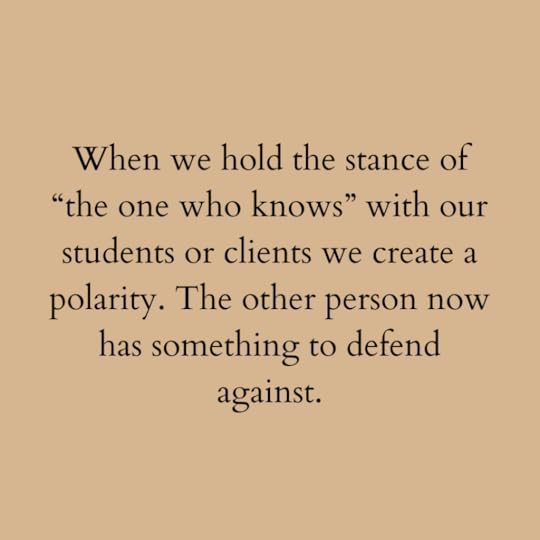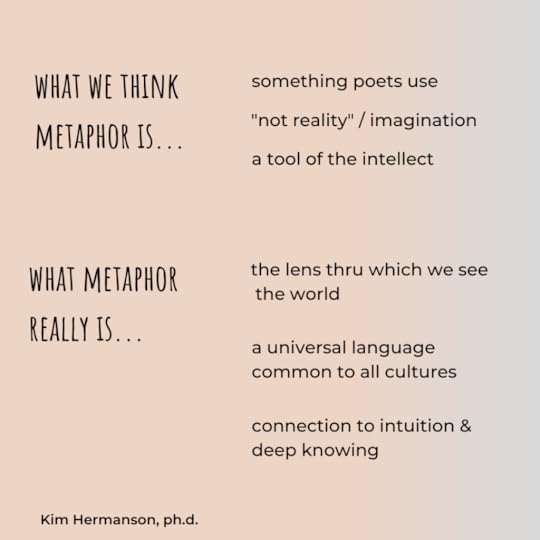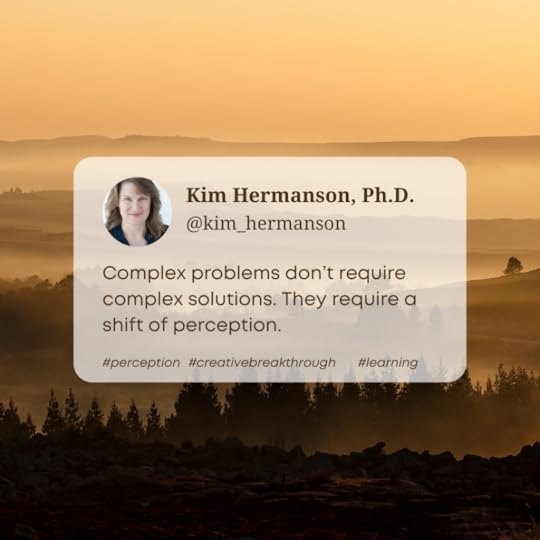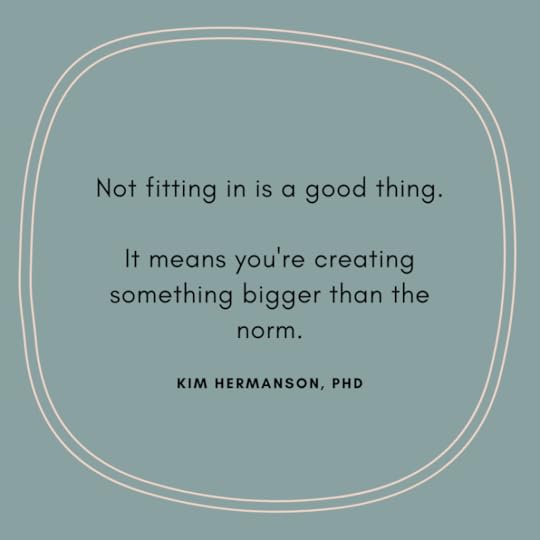Kim Hermanson's Blog, page 5
December 2, 2024
When we hold the stance of “the one who knows” with our students or clients we create a polarity

In his book, POWER IN THE HELPING PROFESSIONS, Jungian psychiatrist Adolf Guggenbuhl discusses how therapists, teachers, and medical practitioners create polarities with clients and students when they take on the role of “knower.” Jungian analyst John R. Haule calls this polarization a “split archetype.”
A split archetype happens whenever we know “what is best” for our patient (or mother, father, student, friend, lover): “One of us is all-knowing and all-powerful, and the other is ignorant, neurotic and powerless.” In such a situation, no healing or creativity has the space to occur, because we’re mired in a fixed (stuck) position.
When we hold the unwavering stance of “the one who knows” we create a polarity. We give the other person something to defend or argue against.
November 27, 2024
It’s counter-intuitive, but opening up space is more important than filling it
It’s counter-intuitive, but opening up space is more important than filling it.
Many who teach, train, coach, or mentor focus on content and strategies, but it’s the opening of space that’s transformative.
When we focus solely on content, learning becomes static. We have no room to let the wisdom under the surface reveal itself.
Today, shift your focus to the space. 
November 25, 2024
Critical thinking: The art of looking deeper
Critical thinking is often misunderstood as the act of finding faults or poking holes in arguments. Perhaps it’s the word “critical” that trips us up, conjuring images of harsh judgment or opposition. But true critical thinking isn’t about tearing things apart—it’s about going deeper.
At its heart, critical thinking is the ability to look beneath the surface of what’s being said or discussed. It’s about uncovering hidden layers and examining not just the content of an idea but also the context and the lenses through which we see it. It’s a practice of depth, inviting us to engage with curiosity rather than judgment.
Here are some key questions that guide true critical thinking:
What unspoken assumptions, values, or belief systems shape this perspective?How does my own lens—my experiences, biases, and emotions—color the way I’m interpreting this?If I feel strongly about an idea or perspective, why? What deeper truths or unresolved tensions might be fueling my reaction?True critical thinkers don’t just skim the surface—they look for the larger ramifications of a discussion and the underlying motivations driving opinions, including their own. They reflect on how the way something is framed reveals deeper truths:
What larger patterns or themes emerge from this discussion?How does this idea connect to the bigger picture of our world?What energizes or inspires me here? What makes me feel stuck or resistant?Critical thinking also asks us to observe our emotional and physical responses:
Am I invigorated or energized by this conversation, or does it make me feel sluggish? Why might this be?Do I feel comfortable in this learning situation? If not, what might that discomfort reveal?By stepping back and reflecting on both the content and the context, we begin to see the full complexity of a topic. We uncover nuances that surface-level analysis misses, gaining insights not only into the subject at hand but also into ourselves.
Ultimately, critical thinking isn’t about being “right.” It’s about expanding our understanding. It’s about asking better questions, examining assumptions, and creating space for discovery. When we approach ideas with openness and a willingness to look deeper, we move beyond critique to connection and wisdom.
True critical thinking doesn’t divide; it broadens. It’s a practice of seeing more fully—and in that deeper seeing, we find clarity, growth, and the opportunity for transformation.
Excerpted from Getting Messy: A Guide to Taking Risks and Opening the Imagination for Teachers, Trainers, Coaches and Mentors.
CRITICAL THINKING redefined: Looking beyond disagreement
CRITICAL THINKING is often confused with finding things to disagree with. Perhaps the word “critical” is what gets in our way.
Actually, critical thinking is more about depth. Critical thinking is the ability to look under the surface of what is being said and discussed. It involves examining our own lenses and perspectives. It’s about looking deeper.
Critical thinkers look under issues and state truths that haven’t been spoken:
What are the larger ramifications of this discussion?
What are the motivations and belief systems that underlie the author or speaker’s opinions and the way he (or she) frames and discusses issues?
What are the motivations and belief systems that underlie my own opinions? Through what lens am I viewing the world?
If I’m having a strong reaction, such as anger or frustration, to a particular book, set of ideas, or person, why might I be having this reaction? What “truth” is underneath my emotional reaction?
What two or three main ideas do I get out of this piece of writing, lecture, or conversation? What ideas here stimulate and inspire me?
Do I feel comfortable in this learning situation? Why or why not? Am I gaining something from this experience?
Is this conversation making me feel invigorated or energized? Or is it making me feel sluggish? Why might this be?
Critical thinking is the ability to look under the surface of what is being said and discussed. It involves examining our own lenses and perspectives through which we’re thinking and responding.
It’s about looking deeper.
Excerpted from Getting Messy: A Guide to Taking Risks and Opening the Imagination for Teachers, Trainers, Coaches and Mentors.
CRITICAL THINKING is often confused with finding things to disagree with
CRITICAL THINKING is often confused with finding things to disagree with. Perhaps the word “critical” is what gets in our way.
Actually, critical thinking is more about depth. Critical thinking is the ability to look under the surface of what is being said and discussed. It involves examining our own lenses and perspectives. It’s about looking deeper.
Critical thinkers look under issues and state truths that haven’t been spoken:
What are the larger ramifications of this discussion?
What are the motivations and belief systems that underlie the author or speaker’s opinions and the way he (or she) frames and discusses issues?
What are the motivations and belief systems that underlie my own opinions? Through what lens am I viewing the world?
If I’m having a strong reaction, such as anger or frustration, to a particular book, set of ideas, or person, why might I be having this reaction? What “truth” is underneath my emotional reaction?
What two or three main ideas do I get out of this piece of writing, lecture, or conversation? What ideas here stimulate and inspire me?
Do I feel comfortable in this learning situation? Why or why not? Am I gaining something from this experience?
Is this conversation making me feel invigorated or energized? Or is it making me feel sluggish? Why might this be?
Critical thinking is the ability to look under the surface of what is being said and discussed. It involves examining our own lenses and perspectives through which we’re thinking and responding.
It’s about looking deeper.
Excerpted from Getting Messy: A Guide to Taking Risks and Opening the Imagination for Teachers, Trainers, Coaches and Mentors.
November 20, 2024
Unlocking deep wisdom through the magic of metaphor
Metaphor is embodied wisdom.
We commonly think of metaphor as something poets use to embellish their language, a tool of the left hemisphere. We also often dismiss it as “not real,” saying, “that’s just a metaphor.”
But metaphor is much more than that.
When we engage with a key metaphor, it connects us with a realm of deep wisdom that lies below the surface of our consciousness. Through metaphor, we directly connect with the creative forces of our world.
We can spend lots of time learning techniques for how to make better decisions. We can make action plans, write lists of pros and cons, and study with experts.
Or, we can step into a realm that organically shifts our ‘sense of being’ and facilitates healing and clarity.
Metaphor isn’t just about words—it’s about experience. When a metaphor truly resonates, it moves through our bodies and emotions, offering insights that logic alone cannot provide. It has the power to reveal truths, spark inspiration, and open doors to transformation in ways that feel effortless yet profound.
Discover how metaphor can unlock your deeper wisdom and reshape your decisions.
Metaphor is embodied wisdom

Metaphor is embodied wisdom.
We commonly think of metaphor as something poets use to embellish their language and a tool of the left hemisphere. We also commonly view it as “not real.” We say, “that’s just a metaphor.”
But metaphor is much more than that.
When we engage with a key metaphor, it connects us with a realm of deep wisdom that lies below the surface of our consciousness. Through metaphor, we directly connect with the creative forces of our world.
We can spend lots of time learning techniques for how to make better decisions. We can make action plans, write lists of pros and cons, and study with experts.
Or, we can step into a realm that organically shifts our ‘sense of being’ and facilitates healing and clarity.
November 18, 2024
It’s a myth that complex problems require complex solutions

It’s a myth that complex problems require complex solutions.
The more complex we get, the more we’re in our heads.
The more time we spend in our heads, the more we’re focusing on the problem and making it worse. Our thinking cycles around, it goes in loops.
So when you’re confused or need a solution, try doing less.
Doing less creates space for magic. It will give you a chance to drop down into your heart where REAL wisdom lives.
Simplicity allows room for healing, depth, and creativity to enter.
November 13, 2024
Creating the space where you belong
The writer and playwright James Baldwin said, “The place in which I’ll fit will not exist until I make it.” These words carry so much truth and empowerment. It’s a reminder that the spaces where we truly belong—the ones that reflect our unique vision, voice, and values—don’t always exist yet. But that doesn’t mean they can’t.
Frank Zappa echoed this sentiment when he said, “Without deviation from the norm, progress is not possible.” It’s only by stepping away from what’s conventional, expected, or already established that we can create something new.
So what if we stopped waiting for those perfect spaces to appear? What if, instead, we started building them ourselves? Let’s imagine a world where everyone has the courage to carve out spaces that honor their authentic selves—places that inspire connection, creativity, and change.
It doesn’t have to be grandiose. It could be as simple as starting a conversation, creating art that reflects your truth, or gathering a community of like-minded people. These small actions ripple outward, sparking progress and shaping the world in unexpected ways.
The world needs your unique perspective, your creative spark, and your willingness to step outside the norm. Let’s make those places where we truly ‘fit’—and in doing so, let’s change the world for the better.
Ready to embrace your unique path? Start creating your space today.
Not fitting is a good thing

The writer and playwright James Baldwin said, “The place in which I’ll fit will not exist until I make it.” Frank Zappa once said, “Without deviation from the norm, progress is not possible.”
Let’s make those places where we ‘fit’…. and change the world.



